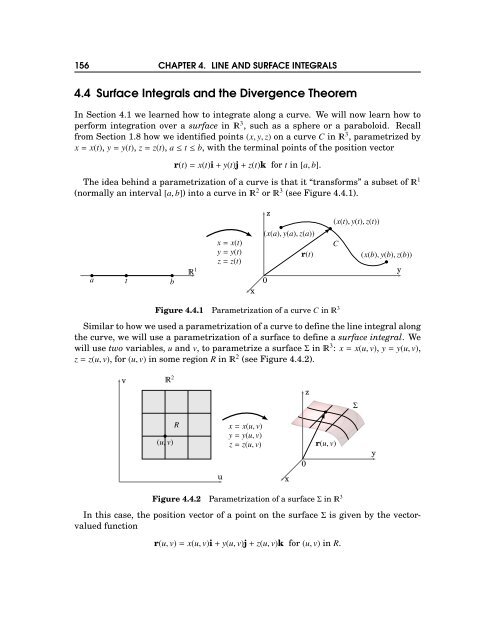156 CHAPTER 4. LINE AND SURFACE INTEGRALS 4.4 Surface Integrals and the Divergence Theorem In Section 4.1 we learned how to integrate along a curve. We will now learn how to perform integration over a surface in 3 , such as a sphere or a paraboloid. Recall from Section 1.8 how we identified points (x,y,z) on a curve C in 3 , parametrized by x= x(t), y=y(t), z=z(t), a≤t≤b, with the terminal points of the position vector r(t)= x(t)i+y(t)j+z(t)k for t in [a,b]. The idea behind a parametrization of a curve is that it “transforms” a subset of 1 (normally an interval [a,b]) into a curve in 2 or 3 (see Figure 4.4.1). a t b 1 x= x(t) y=y(t) z=z(t) x z (x(a),y(a),z(a)) r(t) 0 (x(t),y(t),z(t)) C (x(b),y(b),z(b)) y Figure 4.4.1 Parametrization of a curve C in 3 Similartohowweusedaparametrizationofacurvetodefinethelineintegralalong the curve, we will use a parametrization of a surface to define a surface integral. We will use two variables, u and v, to parametrize a surfaceΣin 3 : x= x(u,v), y=y(u,v), z=z(u,v), for (u,v) in some region R in 2 (see Figure 4.4.2). v 2 z Σ (u,v) R x= x(u,v) y=y(u,v) z=z(u,v) 0 r(u,v) y u x Figure 4.4.2 Parametrization of a surfaceΣin 3 In this case, the position vector of a point on the surfaceΣis given by the vectorvalued function r(u,v)= x(u,v)i+y(u,v)j+z(u,v)k for (u,v) in R.
4.4 Surface Integrals and the Divergence Theorem 157 Since r(u,v) is a function of two variables, define the partial derivatives ∂r ∂u for (u,v) in R by ∂r ∂u (u,v)=∂x ∂u (u,v)i+∂y ∂u (u,v)j+∂z (u,v)k, and ∂u ∂r ∂v (u,v)=∂x ∂v (u,v)i+∂y ∂v (u,v)j+∂z ∂v (u,v)k. and ∂r ∂v The parametrization ofΣcan be thought of as “transforming” a region in 2 (in the uv-plane) into a 2-dimensional surface in 3 . This parametrization of the surface is sometimes called a patch, based on the idea of “patching” the region R ontoΣin the grid-like manner shown in Figure 4.4.2. In fact, those gridlines in R lead us to how we will define a surface integral overΣ. Along the vertical gridlines in R, the variable u is constant. So those lines get mapped tocurvesonΣ,andthevariableuisconstantalongthepositionvectorr(u,v). Thus,the tangent vector to those curves at a point (u,v) is ∂r ∂v . Similarly, the horizontal gridlines in R get mapped to curves onΣwhose tangent vectors are ∂r ∂u . Nowtakeapoint(u,v)inRas,say,thelowerleftcornerofoneoftherectangulargrid sections in R, as shown in Figure 4.4.2. Suppose that this rectangle has a small width and height of∆u and∆v, respectively. The corner points of that rectangle are (u,v), (u+∆u,v), (u+∆u,v+∆v) and (u,v+∆v). So the area of that rectangle is A=∆u∆v. Then that rectangle gets mapped by the parametrization onto some section of the surface Σ which, for∆u and∆v small enough, will have a surface area (call it dσ) that is very close to the area of the parallelogram which has adjacent sides r(u+∆u,v)−r(u,v) (corresponding to the line segment from (u,v) to (u+∆u,v) in R) and r(u,v+∆v)−r(u,v) (corresponding to the line segment from (u,v) to (u,v+∆v) in R). But by combining our usual notion of a partial derivative (see Definition 2.3 in Section 2.2) with that of the derivative of a vector-valued function (see Definition 1.12 in Section 1.8) applied to a function of two variables, we have ∂r ∂u ≈ r(u+∆u,v)−r(u,v) , and ∆u ∂r ∂v ≈ r(u,v+∆v)−r(u,v) , ∆v and so the surface area element dσ is approximately ∥ ∥(r(u+∆u,v)−r(u,v))×(r(u,v+∆v)−r(u,v)) ∥ ∥ ∥≈ ∥ ∥∥∥∥∥ (∆u ∂r ∂u )×(∆v∂r ∂v ) ∥ ∥∥∥∥∥ = ∂r ∥∂u ×∂r ∂v∥ ∆u∆v by Theorem 1.13 in Section 1.4. Thus, the total surface area S ofΣis approximately the sum of all the quantities ∥ ∥ ∂r ∥ ∂u ×∂r ∂v ∥∆u∆v, summed over the rectangles in R. Taking the limit of that sum as the diagonal of the largest rectangle goes to 0 gives S= ∂r ∥∂u ×∂r dudv. (4.26) ∂v∥ R








